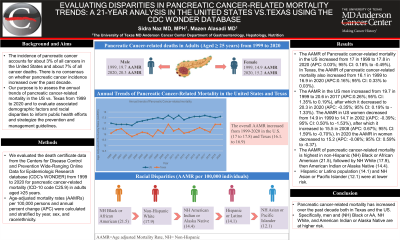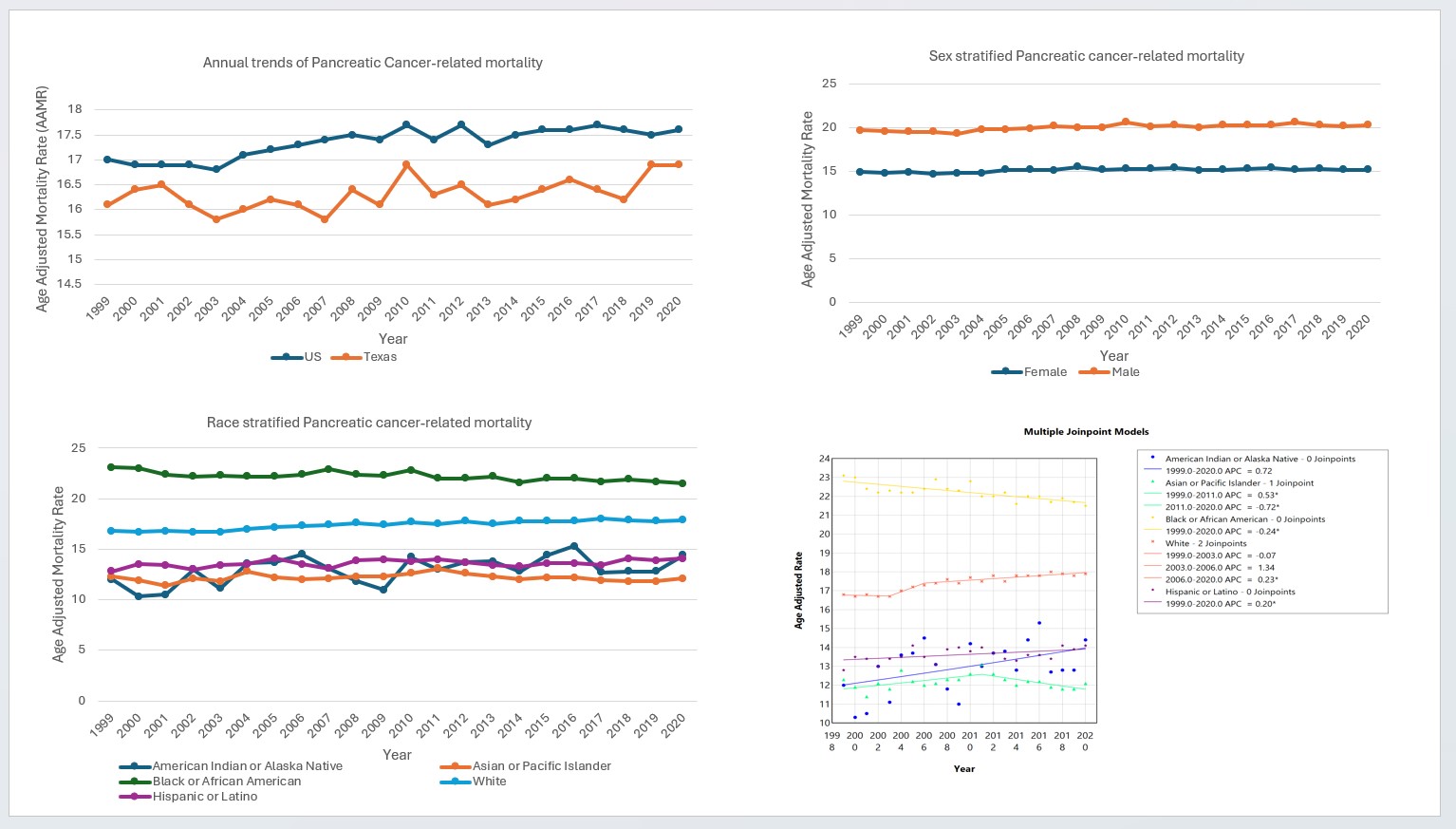Sunday Poster Session
Category: Biliary/Pancreas
P0014 - Evaluating Disparities in Pancreatic Cancer-Related Mortality Trends: A 20-Year Analysis in the United States vs Texas Using the CDC WONDER Database
Sunday, October 27, 2024
3:30 PM - 7:00 PM ET
Location: Exhibit Hall E

Has Audio

Sidra Naz, MD, MPH
University of Texas MD Anderson Cancer Center
Houston, TX
Presenting Author(s)
Sidra Naz, MD, MPH1, Mazen Alasadi, MD2
1University of Texas MD Anderson Cancer Center, Houston, TX; 2The University of Texas MD Anderson Cancer Center, Houston, TX
Introduction: The incidence of pancreatic cancer accounts for about 3% of all cancers in the United States and about 7% of all cancer deaths. There is no consensus on whether pancreatic cancer incidence increased over the past decade. Our purpose is to assess the annual trends of pancreatic cancer-related mortality in the US vs Texas from 1999 to 2020 and to evaluate associated demographic factors and racial disparities to inform public health efforts and strategize the prevention and management guidelines.
Methods:
We evaluated the death certificate data from the Centres for Disease Control and Prevention Wide-Ranging Online Data for Epidemiologic Research database (CDC's WONDER) from 1999 to 2020 for pancreatic cancer-related mortality (ICD-10 code C25.9) in adults aged ≥25 years. Age-adjusted mortality rates (AAMRs) per 100,000 persons and annual percent change (APC) were calculated and stratified by year, sex, and race/ethnicity.
Results: The AAMR of Pancreatic cancer-related mortality in the US increased from 17 in 1999 to 17.7 in 2010 (APC: 0.39%, 95% CI: 1.01% to 0.26%), after which it raised to 17.8 in 2020 (APC: 0.03%; 95% CI: 0.18% to -0.49%). In Texas, the AAMR of pancreatic cancer-related mortality also increased from 1.3 in 1999 to 0.8 in 2020 (APC: 0.16%; 95% CI: 0.33% to 0.03%). The AAMR in the US men increased from 19.7 in 1999 to 20.6 in 2017 (APC: 0.26%; 95% CI: 1.35% to 0.19%) after which it decreased to 20.3 in 2020 (APC: -0.35%; 95% CI: 0.19% to -1.33%). The AAMR in US women decreased from 14.9 in 1999 to 14.7 in 2002 ((APC: -0.39%; 95% CI: 0.50% to -1.53%) after which it increased to 15.5 in 2008 (APC: 0.67%; 95% CI: 1.59% to -0.70%). In 2020 the AAMR in women decreased to 15.2, (APC: -0.06%; 95% CI: 0.59% to -0.37). The AAMR of pancreatic cancer-related mortality is highest in Non-Hispanic (NH) Black or African American (21.5), followed by NH White (17.9), then American Indian or Alaska Native (14.4), and Hispanic or Latino population (14.1) population.
Discussion: Pancreatic cancer-related mortality has increased over the past decade both in Texas and the US, specifically men and (NH) Black or AA, NH White, and American Indian or Alaska Native are at high risk.

Disclosures:
Sidra Naz, MD, MPH1, Mazen Alasadi, MD2. P0014 - Evaluating Disparities in Pancreatic Cancer-Related Mortality Trends: A 20-Year Analysis in the United States vs Texas Using the CDC WONDER Database, ACG 2024 Annual Scientific Meeting Abstracts. Philadelphia, PA: American College of Gastroenterology.
1University of Texas MD Anderson Cancer Center, Houston, TX; 2The University of Texas MD Anderson Cancer Center, Houston, TX
Introduction: The incidence of pancreatic cancer accounts for about 3% of all cancers in the United States and about 7% of all cancer deaths. There is no consensus on whether pancreatic cancer incidence increased over the past decade. Our purpose is to assess the annual trends of pancreatic cancer-related mortality in the US vs Texas from 1999 to 2020 and to evaluate associated demographic factors and racial disparities to inform public health efforts and strategize the prevention and management guidelines.
Methods:
We evaluated the death certificate data from the Centres for Disease Control and Prevention Wide-Ranging Online Data for Epidemiologic Research database (CDC's WONDER) from 1999 to 2020 for pancreatic cancer-related mortality (ICD-10 code C25.9) in adults aged ≥25 years. Age-adjusted mortality rates (AAMRs) per 100,000 persons and annual percent change (APC) were calculated and stratified by year, sex, and race/ethnicity.
Results: The AAMR of Pancreatic cancer-related mortality in the US increased from 17 in 1999 to 17.7 in 2010 (APC: 0.39%, 95% CI: 1.01% to 0.26%), after which it raised to 17.8 in 2020 (APC: 0.03%; 95% CI: 0.18% to -0.49%). In Texas, the AAMR of pancreatic cancer-related mortality also increased from 1.3 in 1999 to 0.8 in 2020 (APC: 0.16%; 95% CI: 0.33% to 0.03%). The AAMR in the US men increased from 19.7 in 1999 to 20.6 in 2017 (APC: 0.26%; 95% CI: 1.35% to 0.19%) after which it decreased to 20.3 in 2020 (APC: -0.35%; 95% CI: 0.19% to -1.33%). The AAMR in US women decreased from 14.9 in 1999 to 14.7 in 2002 ((APC: -0.39%; 95% CI: 0.50% to -1.53%) after which it increased to 15.5 in 2008 (APC: 0.67%; 95% CI: 1.59% to -0.70%). In 2020 the AAMR in women decreased to 15.2, (APC: -0.06%; 95% CI: 0.59% to -0.37). The AAMR of pancreatic cancer-related mortality is highest in Non-Hispanic (NH) Black or African American (21.5), followed by NH White (17.9), then American Indian or Alaska Native (14.4), and Hispanic or Latino population (14.1) population.
Discussion: Pancreatic cancer-related mortality has increased over the past decade both in Texas and the US, specifically men and (NH) Black or AA, NH White, and American Indian or Alaska Native are at high risk.

Figure: Pancreatic cancer mortality trends in the US vs Texas (1999-2020) and racial disparities.
Disclosures:
Sidra Naz indicated no relevant financial relationships.
Mazen Alasadi indicated no relevant financial relationships.
Sidra Naz, MD, MPH1, Mazen Alasadi, MD2. P0014 - Evaluating Disparities in Pancreatic Cancer-Related Mortality Trends: A 20-Year Analysis in the United States vs Texas Using the CDC WONDER Database, ACG 2024 Annual Scientific Meeting Abstracts. Philadelphia, PA: American College of Gastroenterology.
